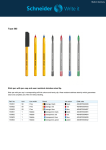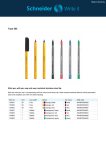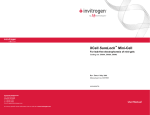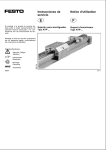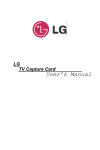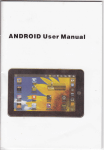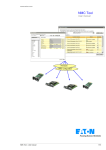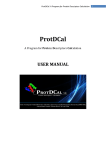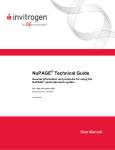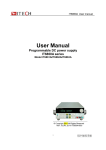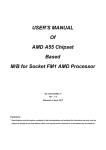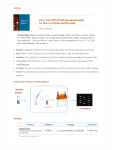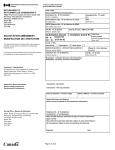Download User Manual - Boca Scientific Laboratory Products
Transcript
Instruction Manual for IDGel™ from DGel Electrosystem Inc For complete protocol and product information, visit www.idgel.com Running IDGel™ • • Using IDGel™ in a Bio-Rad Gel Running Apparatus Prior to inserting the gel in the apparatus - Remove the gasket from the inner frame, then turn the gasket around so that the flat side is facing outwards and re-insert into the inner frame Using IDGel™ in an Invitrogen Gel Running Apparatus - Remove gel from packet and insert into the gel running apparatus. - Along the gel cassette, slide the plastic insert enclosed in the IDGel™ box. - Close the chamber clamp according the manufacturer’s instructions Loading and running IDGel™ Precast Gels: • • • • Dilute the samples to be analyzed with the appropriate volume of sample buffer in sealable micro centrifuge tubes. For protein electrophoresis, heat the samples for 5 min at 100°C, if denaturing conditions are used (SDS-PAGE) Load the samples. Run the gel(s) at an appropriate power supply setting (see table below*) Buffer system Voltage Approx per gel: START Approx per gel: END Current/Wattage: START Current/wattage: END Time Tris-glycine SDS (Laemmli) 150 VDC 250 VDC 30-40 mA 55-65 mA 15-25 mA 30-40 mA 3-7 W 12-16 W 2-6 W 10-14 W 60 min 35 min Tris-glycine (native) 125 VDC 20-30 mA 10-20 mA 2-6 W 1-5 W 100 min Tris-Tricine SDS Tris-acetate EDTA 125 VDC 200 VDC 45--55 mA 45-55 mA 20-30 mA 20-30 mA 4-8 W 8-12 W 2-6 W 3-7 W 60 min 60 min Attention: "IDGel™ is delivered without combs, ready-to-use. Note that, due to the absence of a comb, occasionally the well bottom may seem slightly curved or not flat. This is due to cold temperature during packaging and this normal phenomenon will not affect the gel nor band migration. In fact, the wells will return to their normal flat position when the temperature increases or when buffer is added. Use the gels immediately when removed from the pouch." Opening the IDgel™ cassette • • Hold the cassette with both hands with the notched plate facing you. Press both thumbs onto the larger plate and at the same time pull both spacer extensions with another finger in the opposite direction. Completely separate the cassette halves by slowly pulling them apart with your fingers. Once the gel is free from one of the cassette halves, invert it carefully over the staining, fixing or transfer solution. Using a thin spatula, or one of the spacers, separate the gel from the cassette wall starting at one corner. In general Maximum voltage 250 VDC. The plastic is recyclable (recycling code 1). The acrylamide matrix is colored to see the wells easily. The color will migrate with the migration front. It is non-toxic and does not interfere with proteins or nucleic acids, or with further analysis of your material (Zymogram, Western blot, etc...) © 2006, DGel Electrosystem Inc For research use only. Not for use in clinical diagnostics Patent pending 1 Guide to protein staining procedures Coomassie Blue R-250 staining of proteins. Staining solution Destaining solution Ingredient Brilliant Blue R-250* Methanol Glacial Acetic Acid Distilled water Ingredient Methanol Glacial Acetic Acid distilled water Amount 1g 500 ml 100 ml To 1 liter Amount 250 ml 80 ml to 1 liter Final Stock Conc. 0.1% (w/v) 50% (v/v) 10% (v/v) . Final Stock Conc. 5% (v/v) 8% (v/v) *completely dissolve the dye in methanol and then add the other components Protocol: • • • • Place the gel constant shaking in 100 ml of Staining solution for 20 min Wash the gel with 100 ml distilled water for 10 seconds Destain the gel under constant shaking in 200 ml of Destaining solution with shaking for 30 min Repeat step 3 with fresh Destaining solution until the background is clear (generally, 3 X 30 min; however, time will vary with gel conc.) Silver staining of proteins Place the gel in distilled water Ingredient Amount Final Stock Conc. Gel fixing solution1 Gel fixing solution2 Sensitizer Staining solution* Developing solution* Stop solution Ethanol 50 ml 50% Glacial Acetic Acid 10 ml 10% (v/v) distilled water to 100 ml Ingredient Amount Final Stock Conc. Ethanol 90 ml 30% (v/v) distilled water to 300 ml Ingredient Amount Final Stock Conc. 200 mM Na thiosulfate 400 microliters 0.8 mM distilled water to 100 ml Ingredient Amount Final Stock Conc. Silver nitrate 0.2 g 11.8 mM 37% formaldehyde 54 microliters 0.02% (v/v) distilled water to 100 ml *formaldehyde should be added just before use Ingredient Amount Final Stock Conc. Na carbonate 6.0 g 566 mM 200 mM Na thiosulfate 10 microliters 0.02 mM 37% formaldehyde 54 microliters 0.02% (v/v) *formaldehyde should be added just before use Ingredient Amount Final Stock Conc. Glacial Acetic Acid 5 ml 5% (v/v) distilled water to 100 ml Protocol Note: All steps of the following protocol should be performed under constant gentle shaking. A sufficient amount of solutions should be used; typically, 100 ml is suggested in each step to cover the gel. 1. 2. 3. 4. 5. 6. 7. 8. 9. Fix in Gel Fixing solution 1 for 30 min Wash three times in Gel Fixing solution 2 (each time for 10 min) Treat with Sensitizer for 1 min Rinse twice with distilled water for 1 min each time Stain with Staining solution for 20 min Rinse twice with distilled water for 1 min each time Develop with Developing solution until the protein bands are readily visible (generally 5 to 10 min; avoid prolonged times as this will just increase the background staining) Decant and replace with Stop solution for 10 min Store in distilled water. 2 WESTERN BLOTTING Note: The following protocols for Western blotting provide general information and conditions that may be applied to most transfer procedures. However, careful optimization should be considered if quantitative recovery of a particular protein is required since blotting efficiency is dependent on buffer composition, blotting time and current, membrane used, etc. Transfer with a tank blotting system Transfer buffer (cool to 4C before use) Ingredient Tris-base Glycine Methanol* distilled water Amount 3.0 g 14.4 g 100 - 200 ml to 1 liter Final Stock Conc. 25 mM 192 mM 10 - 20 % *10% methanol is recommended when using PVDF blotting membranes while 20% is recommended when using nitrocellulose-blotting membranes. Transfer protocol 1. 2. 3. 4. 5. 6. 7. 8. Pre-soak the porous pads and two pieces of filter paper cut to the size of the gel (ex. Whatman 3MM paper) in transfer buffer for 5 min Cut a piece of blotting membrane to the size of the gel and equilibrate in transfer buffer. If a PVDF membrane is used, rinse in methanol for 2 min before equilibration in the transfer buffer for 5 min Remove the gel from the cassette and equilibrate in transfer buffer for 5 min Carefully assemble the transfer stack. Remove all air bubbles between the layers. If you do NOT do this then the air bubbles will affect the efficiency of the transfer process and may leave blank spots on the blotting membrane Place the stack into the tank unit making sure it is in the PROPER ORIENTATION. Fill the chamber with transfer buffer Transfer at room temperature at 100 mA for 60 to 120 min When the transfer is complete, turn off the power and remove the layers until you reach the blotting membrane Remove the blotting membrane with a pair of forceps, rinse in distilled water and air-dry for 1 min. Transfer with a semi-dry system Transfer buffer (cool to 4C before use) Ingredient Tris-base Glycine Methanol distilled water Amount 0.3 g 1.44 g 10.0 ml to 100 ml Final Stock Conc. 25 mM 192 mM 10% (v/v) Transfer protocol (wear gloves throughout the procedure) 1. 2. 3. 4. 5. Pre-soak four pieces of blotting membrane to the size of the gel and equilibrate in transfer buffer. If a PVDF membrane is used, rinse it in methanol for 2 min before equilibration in the transfer buffer for 5 min Remove the gel from the cassette. Carefully assemble the transfer stack on the anode (+). Remove all air bubbles between the layers. Air bubbles will affect the efficiency of the transfer process and may leave blank spots on the blotting membrane Transfer at room temperature at 0.8 mA/cm2 of gel (limit voltage to 15 V) for 60 min When the transfer is complete turn off the power and remove layers until you reach the blotting membrane Remove the blotting membrane with a pair of forceps, rinse in distilled water and air-dry for 1 min 3 Monitoring of protein transfer The efficiency of transfer can be monitored using prestained protein markers. Alternatively, the extent of protein transfer can be determined by staining the polyacrylamide gel after the transfer is complete or by staining the proteins directly on the blotting membrane. Proteins on solid support can be stained with dyes such as India ink, Amino Black or Coomassie Blue. A recommended stain is Ponceau S, which is reversible. The detection limit is 1 to 2 micrograms. Ponceau S staining for proteins on solid support Ingredient Ponceau S Glacial Acetic Acid distilled water Amount 0.2 g 1 ml to 100 ml Final Stock Conc. 0.2% (w/v) 1% (v/v) Protocol 1. 2. 3. 4. If the blotting membrane is dry, re hydrate it with water (or methanol, if PVDF) for 5 min Stain the blotting membrane under constant shaking with the Ponceau S solution for 5 min Destain the membrane under constant shaking with distilled water If required, wash the blot with 0.1N NaOH to remove the stain completely 4




